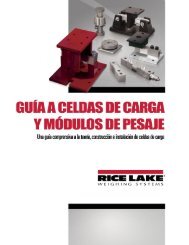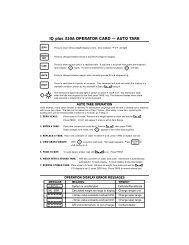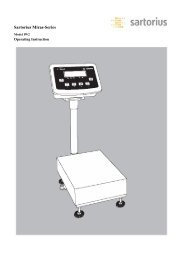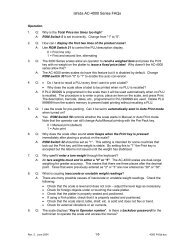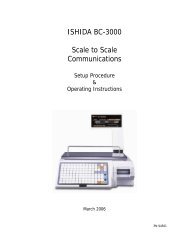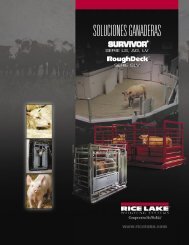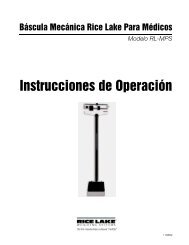English - Rice Lake Weighing Systems
English - Rice Lake Weighing Systems
English - Rice Lake Weighing Systems
You also want an ePaper? Increase the reach of your titles
YUMPU automatically turns print PDFs into web optimized ePapers that Google loves.
On location<br />
On location<br />
In 1955, the world of blue jeans changed forever. When James<br />
Dean donned his iconic denim threads in Rebel without a Cause, pop culture<br />
instantly adopted the look. No longer were they referred to as “waist overalls” most<br />
commonly worn by painters, mechanics, and old cowboys. Blue jeans became cool,<br />
every teenager wanted a pair, and the demand hasn’t let up in the over half-century<br />
since. Today, the $700 billion global blue jeans market is so prevalent in America that<br />
12 pairs are sold every second in the U.S., and the average American owns seven pairs.<br />
Few things are more identifiable with American culture as blue jeans.<br />
The blue jean has greatly evolved since its popularity skyrocketed. A solid-blue straightleg<br />
soon wasn’t stylish enough. Stone-washed, distressed, and every shade of blue now<br />
fill walls of clothing stores, but few know how these styles are achieved.<br />
How Micro-Organisms Shape<br />
the Blue Jean Industry<br />
Initially, special pumice stones were<br />
used to customize jean appearance;<br />
however, they had major<br />
drawbacks. Not only did<br />
they weaken the jeans,<br />
they also produced inconsistent<br />
results and<br />
were environmentally<br />
unsafe. Special<br />
machines had to be<br />
used to wash the jeans<br />
with the stones. In the<br />
late 1980s, the industry<br />
developed what is now<br />
used today: tiny proteins<br />
known as enzymes to “biostone”<br />
denim. These environmentally<br />
friendly chemicals are<br />
naturally created by living organisms, which is<br />
more economical. They also produce repeatable<br />
results and maintain the jeans’ structural integrity.<br />
It’s as if James Dean combined forces with<br />
Albert Einstein for the benefit of fashion!<br />
IOGEN Corporation is a leader in enzyme<br />
research and implementation. They manipulate<br />
micro-organisms to produce specific enzymes<br />
that facilitate production of a wide variety of<br />
products, including ethanol, papers and textiles,<br />
and, of course, blue jeans—so, if one drives to a<br />
clothing store using ethanol-enhanced gasoline<br />
and writes a check for blue jeans, IOGEN can be<br />
thanked for making the entire process possible.<br />
But IOGEN’s laboratories in Ottawa, Canada,<br />
had a problem. Fiber-digesting enzymes<br />
floating around in fermentation chambers are<br />
difficult to measure. Quantities are important<br />
so enzyme levels can be monitored as they are<br />
researched. At first, they used a marker to label<br />
the chambers with lines indicating fluid levels,<br />
but more precise measurements were desperately<br />
needed.<br />
Continued on page 17<br />
14 RICE LAKE MAGAZINE | www.ricelake.com<br />
www.ricelake.com | RICE LAKE MAGAZINE 15



